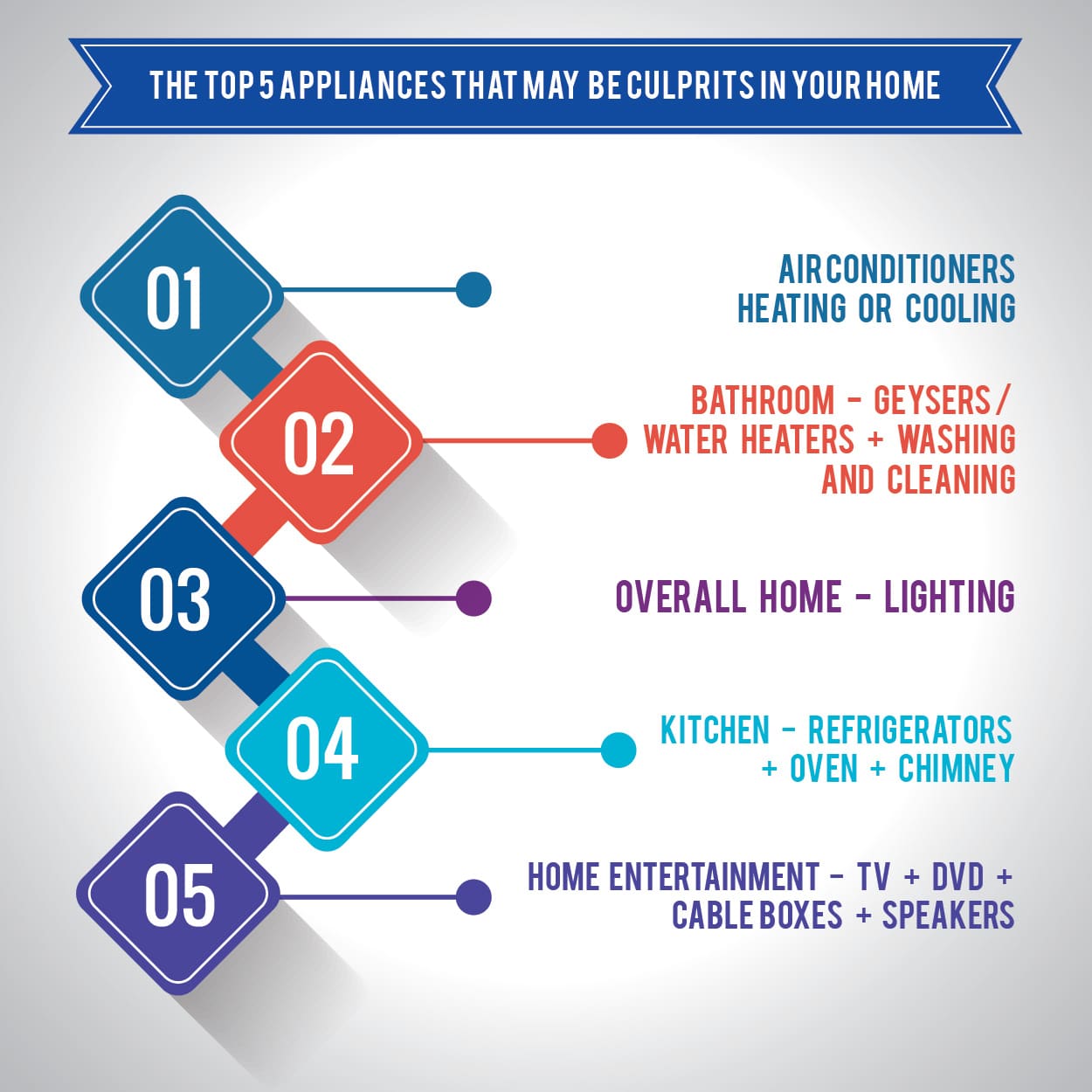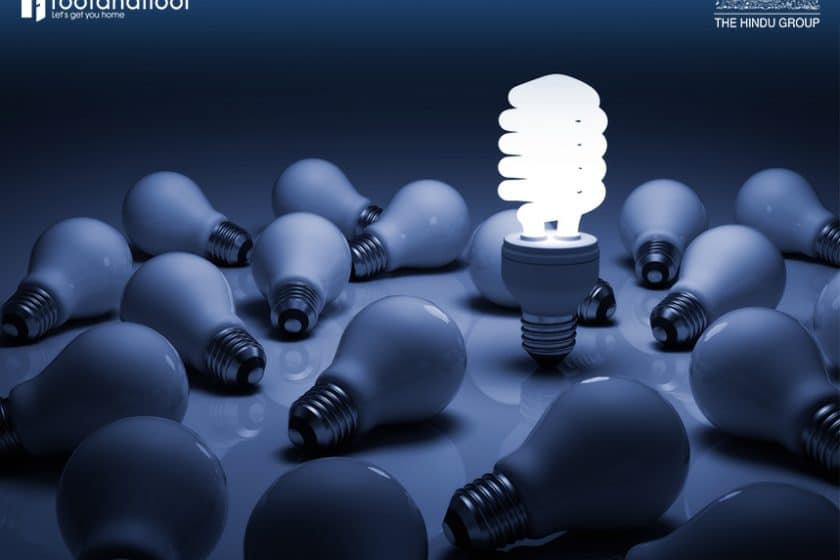Did you know that only 10% of the energy supplied to a traditional light bulb is utilised to make light? The remaining 90% produces heat which is practically, wasted energy.
And did you know that cooling and heating makes up a significant part of your energy usage?
With physical things, it’s easy to measure and quantify wastage. For example, with food and water, you can perceive the volume that is being misused, and take suitable action.
Electrical wastage, however, cannot be as tangibly perceived or measured. And even with the billing units handy at your disposal, it can be quite hard to nail down what exactly could be contributing to your high energy usage.
To help you address this problem, we’ve made a comparison of the most used appliances that make up our everyday lives. With a view to show you, how they stack up against one another in their pursuit for power. (quite literally)
Let’s run through a comparative analysis then, shall we?
The Comparative Analysis
Below, we’ve listed three categories of appliances based on their particular power ratings.
What is equally or probably even more important to note beside the power ratings is the duration for which these appliances are used.
Both these factors – namely, the power rating and the running time, account for the total usage. And we’ll show you how the two are inter-related.
Here are the three categories for you.
The Power Hungry Elites
These are appliances that have an extremely high power rating. Could you guess which devices are included in this group? Go on, give it a try.
Well, any appliance that has anything even remotely to do with heating or cooling makes it to this category.
As a rule of thumb, remember that both heating and cooling are extremely energy intensive processes. Also, these are appliances that comfortably make it to the 1000 Watt mark. They include items like

(Note: W -> Watt)
- MICROWAVE OVEN 700 W TO 1000 W
- GEYSERS 1000 W TO 3000 W
- ELECTRIC KETTLE 1000 W TO 2000 W
- DISHWASHER 1200 W TO 1500W
- INDUCTION COOKER 1000 W TO 1500 W
- ELECTRICAL IRON 750 W TO 1000 W
- TOASTER 800 W TO 1800W
- AIR CONDITIONER 1500 W TO 2500 W
- HAIR DRYER 1300 W TO 1875 W
- COFFEE MAKERS 600 W TO 1200 W
- ROOM HEATERS 1000 W TO 1,500 W
Tip: Use these items with discretion and remember to switch them off timely as they guzzle down a lot of power.
The Moderates
Now, this category of appliances have a much lower power rating than the previous group. Nonetheless, they’re still very vital contributors to your energy usage.
- MIXER GRINDER/BLENDER/JUICER 450 W
- FRIDGE 150W TO 400W
- WASHING MACHINE 250 W TO 750 W
- TELEVISION 50 W TO 300 W ( VARIES BY TV TECHNOLOGY AND SIZE )
- VACUUM CLEANER 500 W
- KITCHEN CHIMNEY 350 W
Note – Although these items have a relatively lower power rating, you may find yourself using them more frequently.
The Modest
This is the third category. And it includes appliances that you probably use quite frequently in the course of your day-to-day activities.
Here are the ratings below.
- HOME THEATRE 150 W
- GAMING CONSOLES 50 TO 150 W
- DESKTOP COMPUTER 100 W
- LAPTOP 65 W TO 250 W
- PEDESTAL FAN (PER FAN) 100 W
- PRINTER 25 W
- CABLE TV BOXES 35 W
- EXHAUST FAN 40 W TO 100 W
- CEILING FAN (PER FAN) 40 TO 75 W
- TABLETS & MOBILE CHARGER 5 W TO 10 W
- WIRELESS ROUTER 5 W TO 15 W
- ELECTRIC SHAVER 15 W TO 20 W
- LIGHTING AND LIGHTS (EACH LIGHT) 20 W TO 100 W
Gaining perspective
As we’d mentioned earlier, just knowing the ratings for these appliances isn’t enough. Why? Because energy units are calculated based on both, the wattage (power rating) and the time for which the appliance is used.
So lets’ see how it works.
Let’s say; you use a hair dryer for 30 minutes daily, and the ceiling fan for about eight hours every day. So if you were to calculate the energy consumption for both these appliances, here’s how you’d do it.
For the hair dryer, your daily consumption would stand to be
1300 Watts X 0.5 hours / 1000 = 0.65 units
But, for the ceiling fan, your daily consumption would be
75 Watts X 8 hours / 1000 = 0.6 units
So now, you can start comparing. In this case, isn’t it interesting to note that the power usage for running a hair dryer for 30 minutes equates to almost 8 hours of a running fan?
With this approach, you’ll quickly gain insight on what are the top energy wasting appliances in your home. And you’ll be able track down those devices contributing the most to your energy wastage.
Power phantoms and power vampires
While we’re on the subject of energy wasting appliances, let’s talk a bit about power phantoms and power vampires.
As you may already know, there are several appliances in our homes like the TV or Microwave or Set-top box that are often left in standby mode so that they can be instantly turned on for operation.
Think screen-savers, the turned-on microwave timers, plugged in chargers, desktop monitors with yellow standby lights…
Now, if you wish to reduce energy wastage, you need to realise that these appliances in standby mode continue to consume quite a bit of power. Even though they are not in operation. This is truer if these appliances are old and not recent.
The term power vampires is used to refer to these devices which (like vampires) continue draining power off your socket even when they’re supposedly not running.
And you’d be surprised to know how much you could save annually, had you turned these devices off or unplugged them entirely.
Here’s an interesting statistic from the United States –
The Union of Concerned Scientists says, “This extra electricity [from power vampires] costs consumers more than $5.8 billion annually and sends more than 87 billion pounds of heat-trapping carbon dioxide into the atmosphere each year.
Now, that’s a lot of money and energy down the drain.
The top 5 appliances that may be culprits in your home
With the above analysis, here is a handy list of the top five appliances that could be skyrocketing your energy usage.

- Air conditioners – Heating or Cooling
- Bathroom – Geysers / Water Heaters + Washing and cleaning
- Overall home – Lighting
- Kitchen – Refrigerators + Oven + Chimney
- Home entertainment – TV + DVD + Cable Boxes + Speakers
Summary
We hope this guide helps you raise your awareness of what is really contributing to your energy wastage. And hopefully, it’ll also help you save a lot of money and power in the long run as well.
Do you have any thoughts on energy wasting appliances that you’d like to share with us? Anything we’ve missed out on? If so, do share those in the comments below. We’d love to hear from you.


